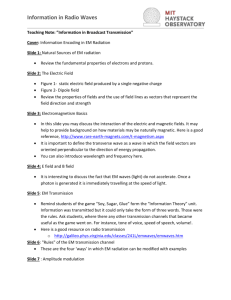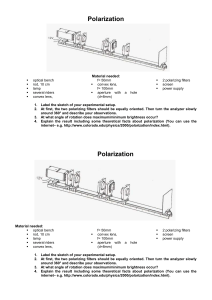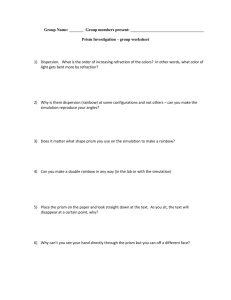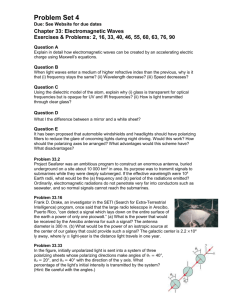ANALYZE (a) The 90° rotation of the polarization direction
advertisement
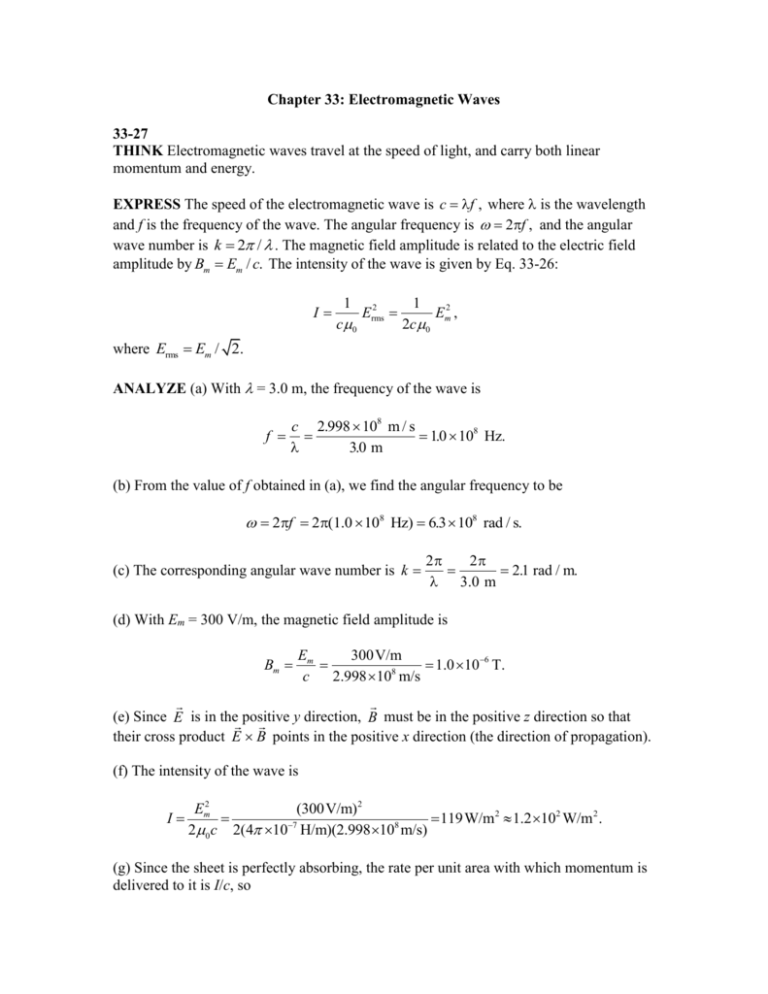
Chapter 33: Electromagnetic Waves 33-27 THINK Electromagnetic waves travel at the speed of light, and carry both linear momentum and energy. EXPRESS The speed of the electromagnetic wave is c f , where is the wavelength and f is the frequency of the wave. The angular frequency is 2f , and the angular wave number is k 2 / . The magnetic field amplitude is related to the electric field amplitude by Bm Em / c. The intensity of the wave is given by Eq. 33-26: I 1 c 0 2 Erms 1 Em2 , 2c0 where Erms Em / 2. ANALYZE (a) With = 3.0 m, the frequency of the wave is f c 2.998 108 m / s 10 . 108 Hz. 3.0 m (b) From the value of f obtained in (a), we find the angular frequency to be 2f 2 Hz) 6.3 108 rad / s. (c) The corresponding angular wave number is k 2 2 2.1 rad / m. m (d) With Em = 300 V/m, the magnetic field amplitude is Bm Em 300V/m 1.0 106 T. c 2.998 108 m/s (e) Since E is in the positive y direction, must be in the positive z direction so that B their cross product E B points in the positive x direction (the direction of propagation). (f) The intensity of the wave is Em2 (300V/m)2 I 119W/m2 1.2 102 W/m 2 . 8 20c 2(4 H/m)(2.998 10 m/s) (g) Since the sheet is perfectly absorbing, the rate per unit area with which momentum is delivered to it is I/c, so dp IA (119 W / m2 )(2.0 m2 ) 8.0 107 N. 8 dt c 2.998 10 m / s dp / dt 8.0 107 N (h) The radiation pressure is pr 4.0 107 Pa. 2 A 2.0 m LEARN The energy density in this case is given by u I 119 W/m 2 4.0 107 J/m3 c 2.998 108 m/s which is the same as the radiation pressure pr. 33-37 THINK A polarizing sheet can change the direction of polarization of the incident beam since it allows only the component that is parallel to its polarization direction to pass. EXPRESS The 90° rotation of the polarization direction cannot be done with a single sheet. If a sheet is placed with its polarizing direction at an angle of 90° to the direction of polarization of the incident radiation, no radiation is transmitted. ANALYZE (a) The 90° rotation of the polarization direction can be done with two sheets. We place the first sheet with its polarizing direction at some angle , between 0° and 90°, to the direction of polarization of the incident radiation. Place the second sheet with its polarizing direction at 90° to the polarization direction of the incident radiation. The transmitted radiation is then polarized at 90° to the incident polarization direction. The intensity is I I 0 cos 2 cos 2 (90 ) I 0 cos 2 sin 2 , where I 0 is the incident radiation. If is not 0° or 90°, the transmitted intensity is not zero. (b) Consider n sheets, with the polarizing direction of the first sheet making an angle of = 90°/n relative to the direction of polarization of the incident radiation. The polarizing direction of each successive sheet is rotated 90°/n in the same sense from the polarizing direction of the previous sheet. The transmitted radiation is polarized, with its direction of polarization making an angle of 90° with the direction of polarization of the incident radiation. The intensity is I I 0 cos 2 n (90 / n) . We want the smallest integer value of n for which this is greater than 0.60I0. We start with n = 2 and calculate cos2 n (90 / n) . If the result is greater than 0.60, we have obtained the solution. If it is less, increase n by 1 and try again. We repeat this process, increasing n by 1 each time, until we have a value for which cos2 n (90 / n) is greater than 0.60. The first one will be n = 5. LEARN The intensities associated with n = 1 to 5 are: I n 1 I 0 cos 2 (90) 0 I n 2 I 0 cos 4 (45) I 0 / 4 0.25 I 0 I n 3 I 0 cos 6 (30) 0.422 I 0 I n 4 I 0 cos8 (22.5) 0.531I 0 I n 5 I 0 cos10 (18) 0.605 I 0 . Thus, I > 0.60I0 with 5 sheets. 33-53 THINK The angle with which the light beam emerges from the triangular prism depends on the index of refraction of the prism. EXPRESS Consider diagram (a) shown next. The incident angle is and the angle of refraction is 2. Since 2 90 and 2 180, we have 2 90 90 1 180 . 2 2 (a) (b) ANALYZE Next, examine diagram (b) and consider the triangle formed by the two normals and the ray in the interior. One can show that is given by 2( 2 ) . Upon substituting /2 for 2, we obtain 2( / 2) which yields ( ) / 2. Thus, using the law of refraction, we find the index of refraction of the prism to be n sin sin 12 ( ) . sin 2 sin 12 LEARN The angle is called the deviation angle. Physically, it represents the total angle through which the beam has turned while passing through the prism. This angle is minimum when the beam passes through the prism “symmetrically,” as it does in this case. Knowing the value of and allows us to determine the value of n for the prism material.


